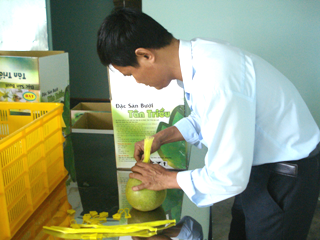 |
|
|
Packaging stage for grapefruit export at Tan Trieu Grapefruit Cooperative |
In Dong Nai, in recent years,
thanks to provincial authority’s regards, agricultural sector has been able to
work out many policies to support, transfer and operate technological and
scientific advances into production, typically from soil preparation, seed
selection, care, pest and disease control and proper harvesting method. There
have been many techniques being applied such as “3 decreases and 3 rises” for
rice, the intensive cultivation of hybrid maize, integrated pest management (IPM)
for vegetable, improved grafting for coffee, the investment of water efficient
irrigation combined with pipeline fertilization, etc. These approaches have
contributed to forming some areas of intensive cultivation and gradually raise
farmer’s awareness of sci-tech application into production. According to
Department of Agriculture and Rural Development, in the entire province, there
are 346 thousand hectares of perennial and annual plants, providing more than 1
million tons of agricultural products on market. This is considered as the
abundant materials for pre-processing and processing factories. However,
generally speaking, the production is not considerable and most of agricultural
products are harvested by human force. The pre-processing and processing are
just completed by several enterprises and farmers usually sell their
newly-harvested products on the spot. Therefore, it is inevitable for them to
control losses. Among these agricultural products, fruits are at the high rate
of loss during harvest, transportation and pre-processing (around 19%). The
followings are leafy and fruity vegetable (13-14%), rice (13%), coffee (more
than 7%), maize (6%), cashew (6%), and pepper (3%), etc.
 |
|
|
At present, most of agricultural products are sold in the raw form, which can cause critical losses. |
With regard to fruits, since most of them are grown in an area of remote and difficult traffic conditions, transportation can affect the rate of loss. The pre-processing and processing stages are fairly low. Most of fruits are consumed raw or freezed in the spongy container or basket. For rice, after harvest, the traditional drying as quick sunlight exposure is applied by exposing rice in the hot sunlight on the cement, brick floor during 2 or 3 consecutive days. With this drying, rice is easy to splitted in the milling stage. Besides, because of lack of drying courtyard, many agricultural products can be affected by low quality and imprecise quantity, particularly for coffee and pepper. Mr. Vo Van Thanh, one farmer of pepper cultivation in Hung Loc commune, Thong Nhat district, said: “During the peak time, while they have to employ laborers for picking pepper, they also have to make use of street pavements to dry peppers due to lack of drying courtyards. It can lead to sand and gravels mixed into peppers, which can critically lower agricultural product quality. If the harvest is coincident with 3 – 4 days, farmers have to sell raw peppers to traders with the low price because of fear of being spoiled”.
At present, while modern drying factories are short of materials, the local drying facilities are solving around 30% of drying demands, unfit with the yield of rice and maize during rainy season for local consumption. In respect of storage, there are now the storage of agricultural managed by private companies that can meet the drying standard but fail to procure product of proper moisture that can cause losses during storage stage. Due to no standard storage warehouse, farmers usually store their products for use until next crop and sell out all the remaining ones to traders. Those farmers who have good economic condition will keep it in short time to expect the higher selling price.
 |
|
|
In recent time, many farmers in the province are investing in mechanization into their production. |
To deal with it, Dong Nai has proposed a plan “the mechanism and policy of post-harvest control for agricultural and aquatic products by 2015 and oriented by 2020”. The plan is very necessary in the context of outdated harvesting and processing technology. However, in addition to the mechanism and policy for farmer’s supports, the cooperation and forming of economic organizations (high-productivity clubs, cooperative groups and cooperatives, etc.) should be encouraged to invest in agricultural machines and production mechanization and application of technological advances into the storage. Then, it can contribute to solving the post-harvest problem for agricultural products and the effort should be made to uphold its effectiveness.
Reported by Ba Thong, Translated by Minh Minh
Author: phongvien
Newer articles
Older articles
Today
Total